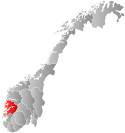
Bruvik (municipality)
Bruvik Municipality
Bruvik herad | |
|---|---|
 Bruvik on Osterøy island, seen from the top of Brøknipa | |
 Hordaland within Norway | |
 Bruvik within Hordaland | |
| Coordinates: 60°28′50″N 05°41′00″E / 60.48056°N 5.68333°E | |
| Country | Norway |
| County | Hordaland |
| District | Nordhordland |
| Established | 1 Jan 1870 |
| • Preceded by | Haus Municipality |
| Disestablished | 1 Jan 1964 |
| • Succeeded by | Vaksdal and Osterøy municipalities |
| Administrative centre | Bruvik |
| Government | |
| • Mayor (1960-1963) | Jan Hermann Hermansen |
| Area (upon dissolution) | |
| • Total | 391 km2 (151 sq mi) |
| Population (1963) | |
| • Total | 5,673 |
| • Density | 15/km2 (38/sq mi) |
| Demonym | Bruviking[1] |
| Time zone | UTC+01:00 (CET) |
| • Summer (DST) | UTC+02:00 (CEST) |
| ISO 3166 code | NO-1251[2] |
Bruvik is a former municipality in the old Hordaland county, Norway. The municipality existed from 1870 until its dissolution in 1964. At the time of its dissolution, the municipality covered 391 square kilometres (151 sq mi) on both sides of the Veafjorden, the innermost part of the Sørfjorden, including the southeastern part of the island of Osterøy. The administrative centre of the municipality was the village of Bruvik where Bruvik Church is located.[3]

History
The parish of Haus was established as a municipality on 1 January 1838 (see formannskapsdistrikt law). On 1 January 1870, the northeastern district of Haus (population: 2,062) was separated from Haus to form the new municipality of Bruvik.[4]

During the 1960s, there were many municipal mergers across Norway due to the work of the Schei Committee. On 1 January 1964, the municipality of Bruvik was dissolved and its lands were split up as follows:[4]

- the area around the village of Bruvik on the island of Osterøy (population: 409) was merged with parts of the municipalities of Haus (population: 2,237), Hamre (population: 1,166), and Hosanger (population: 1,616) to create the new Osterøy Municipality.
- the rest of Bruvik (population: 5,264), was merged with a parts of the municipalities of Evanger (population: 251) and Modalen (population: 151) to create the new Vaksdal Municipality.
Name
The municipality (originally the parish) is named after the old Bruvik farm (Old Norse: Brúnvíkr) since the first Bruvik Church was built there. The first element is brún which means "mountain ridge" or "rim". The last element is the genitive case of the word vík which means "bay", "cove" or "inlet". Thus it means the bay by the mountain ridge.[5]

Coat of arms
The coat of arms was granted on 14 December 1960. The blazon was "Azure, a chevron over a cogwheel argent". This means the arms have a blue field (background) and the charge is a cogwheel with a chevron ordinary above it. The charge has a tincture of argent which means it is commonly colored white, but if it is made out of metal, then silver is used. The design was chosen to symbolize the importance of industry in the municipality. In 1964 when Bruvik municipality was dissolved, the new municipality of Vaksdal (which included the majority of the old Bruvik municipality) chose to continue using the old arms of Bruvik. Vaksdal used the arms until 1990 when new arms were adopted.[6]

Government
During its existence, this municipality was governed by a municipal council of directly elected representatives. The mayor was indirectly elected by a vote of the municipal council.[7]

Mayors
The mayors (Nynorsk: ordførar) of Bruvik:[8]

- 1870–1877: Anders Johannesson Sandvik
- 1878–1879: Nils Monsson Helle
- 1880–1885: Nils Haldorsen Faugstad
- 1886–1891: Anders Olson Herfindal
- 1892–1893: Anders A. Boge
- 1894–1907: Nils Larsen Eknes
- 1908–1911: Martinius Rimmereid
- 1911–1913: Hans Mathiasson Brørvik
- 1914–1916: Martinius Rimmereid
- 1917–1919: Hans Mathiasson Brørvik
- 1920-1928: John Haldorson Dale
- 1929–1937: Olaf Rimmereid
- 1938–1940: Arnfinn Nygaard
- 1941–1945: Andreas Johannesson Dahle
- 1945-1945: Arnfinn Nygård
- 1946–1957: Knut Severin Jakobsen Vik
- 1958–1959: Steinar Salhus
- 1959-1959: Bernhard Johannesson Trettenes
- 1960–1963: Jan Hermann Hermansen
Municipal council
The municipal council (Heradsstyre) of Bruvik was made up of 37 representatives that were elected to four year terms. The party breakdown of the final municipal council was as follows:

| Party name (in Nynorsk) | Number of representatives | |
|---|---|---|
| Labour Party (Arbeidarpartiet) | 20 | |
| Christian Democratic Party (Kristeleg Folkeparti) | 7 | |
| Liberal Party (Venstre) | 6 | |
| Local List(s) (Lokale lister) | 4 | |
| Total number of members: | 37 | |
| Party name (in Nynorsk) | Number of representatives | |
|---|---|---|
| Labour Party (Arbeidarpartiet) | 22 | |
| Christian Democratic Party (Kristeleg Folkeparti) | 4 | |
| Farmers' Party (Bondepartiet) | 2 | |
| Local List(s) (Lokale lister) | 9 | |
| Total number of members: | 37 | |
| Party name (in Nynorsk) | Number of representatives | |
|---|---|---|
| Labour Party (Arbeidarpartiet) | 20 | |
| Joint List(s) of Non-Socialist Parties (Borgarlege Felleslister) | 13 | |
| Local List(s) (Lokale lister) | 3 | |
| Total number of members: | 36 | |
| Party name (in Nynorsk) | Number of representatives | |
|---|---|---|
| Labour Party (Arbeidarpartiet) | 17 | |
| Communist Party (Kommunistiske Parti) | 3 | |
| Local List(s) (Lokale lister) | 16 | |
| Total number of members: | 36 | |
| Party name (in Nynorsk) | Number of representatives | |
|---|---|---|
| Labour Party (Arbeidarpartiet) | 16 | |
| Communist Party (Kommunistiske Parti) | 4 | |
| List of workers, fishermen, and small farmholders (Arbeidarar, fiskarar, småbrukarar liste) | 3 | |
| Local List(s) (Lokale lister) | 13 | |
| Total number of members: | 36 | |
| Party name (in Nynorsk) | Number of representatives | |
|---|---|---|
| Labour Party (Arbeidarpartiet) | 11 | |
| Liberal Party (Venstre) | 5 | |
| Joint List(s) of Non-Socialist Parties (Borgarlege Felleslister) | 11 | |
| Local List(s) (Lokale lister) | 9 | |
| Total number of members: | 36 | |
| Note: Due to the German occupation of Norway during World War II, no elections were held for new municipal councils until after the war ended in 1945. | ||
See also
References
- ^ "Navn på steder og personer: Innbyggjarnamn" (in Norwegian). Språkrådet.
- ^ Bolstad, Erik; Thorsnæs, Geir, eds. (26 January 2023). "Kommunenummer". Store norske leksikon (in Norwegian). Kunnskapsforlaget.
- ^ Store norske leksikon. "Bruvik" (in Norwegian). Retrieved 23 April 2014.
- ^ a b Jukvam, Dag (1999). Historisk oversikt over endringer i kommune- og fylkesinndelingen (PDF) (in Norwegian). Statistisk sentralbyrå. ISBN 9788253746845.
- ^ Rygh, Oluf (1910). Norske gaardnavne: Søndre Bergenhus amt (in Norwegian) (11 ed.). Kristiania, Norge: W. C. Fabritius & sønners bogtrikkeri. p. 314.
- ^ "Civic heraldry of Norway - Norske Kommunevåpen". Heraldry of the World. Retrieved 18 May 2023.
- ^ Hansen, Tore; Vabo, Signy Irene, eds. (20 September 2022). "kommunestyre". Store norske leksikon (in Norwegian). Kunnskapsforlaget. Retrieved 1 January 2023.
- ^ "Ordførere i Bruvik". LokalHistorieWiki.no (in Norwegian). Retrieved 22 June 2023.
- ^ "Kommunevalgene og Ordførervalgene 1959" (PDF) (in Norwegian). Oslo: Statistisk sentralbyrå. 1960. Retrieved 15 February 2020.
- ^ "Kommunevalgene og Ordførervalgene 1955" (PDF) (in Norwegian). Oslo: Statistisk sentralbyrå. 1957. Retrieved 16 February 2020.
- ^ "Kommunevalgene og Ordførervalgene 1951" (PDF) (in Norwegian). Oslo: Statistisk sentralbyrå. 1952. Retrieved 16 February 2020.
- ^ "Kommunevalgene og Ordførervalgene 1947" (PDF) (in Norwegian). Oslo: Statistisk sentralbyrå. 1948. Retrieved 16 February 2020.
- ^ "Kommunevalgene og Ordførervalgene 1945" (PDF) (in Norwegian). Oslo: Statistisk sentralbyrå. 1947. Retrieved 16 February 2020.
- ^ "Kommunevalgene og Ordførervalgene 1937" (PDF) (in Norwegian). Oslo: Statistisk sentralbyrå. 1938. Retrieved 16 May 2020.
External links

See what we do next...
OR
By submitting your email or phone number, you're giving mschf permission to send you email and/or recurring marketing texts. Data rates may apply. Text stop to cancel, help for help.
Success: You're subscribed now !


